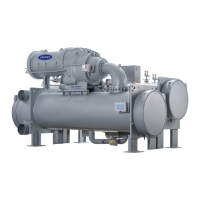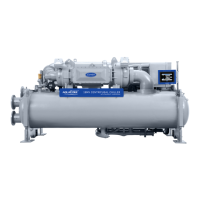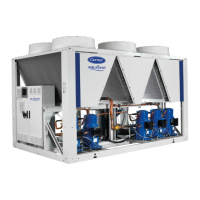35
CHILLER EQUALIZATION WITHOUT A PUMPOUT UNIT
To equalize the pressure differential on a refrigerant isolated 19XR
chiller, use the terminate lockout function PUMPDOWN/LOCK-
OUT (located in the Maintenance Menu). This helps to turn on
pumps and advises the operator on proper procedures.
The following steps describe how to equalize refrigerant pres-
sure in an isolated 19XR chiller without a pumpout unit.
1. Access terminate lockout function on the Maintenance
Menu. (Alternatively, the Quick Test provides a means for
cooler and condenser pump control.)
2. Slowly open the refrigerant charging valves. The chiller
cooler and condenser pressures will gradually equalize.
This process takes approximately 15 minutes.
3. Once the pressures have equalized, the cooler isolation
valve, the condenser isolation valve, and the hot gas isola-
tion valve may now be opened. Refer to Fig. 33 and 34 for
the location of the valves.
CHILLER EQUALIZATION WITH FREE-STANDING
PUMPOUT UNIT
The following steps describe how to equalize refrigerant pres-
sure on an isolated 19XR chiller using the pumpout unit.
1. Access the terminate lockout function on the PUMPDOWN/
LOCKOUT screen (located in the Maintenance Menu).
2. Open valve 4 on the pumpout unit and open valves 1a and
1b on the chiller cooler and condenser, Fig. 33 and 34.
Slowly open valve 2 on the pumpout unit to equalize the
pressure. This process takes approximately 15 minutes.
3. Once the pressures have equalized, the discharge isolation
valve, cooler isolation valve, optional hot gas bypass isola-
tion valve, and refrigerant isolation valve can be opened.
Close valves 1a and 1b, and all pumpout unit valves.
The full refrigerant charge on the 19XR chiller will vary with
chiller components and design conditions, as indicated on the
job data specifications. An approximate charge may be deter-
mined by adding the condenser charge to the cooler charge as
listed in the Heat Exchanger Data tables in the Physical Data
section that begins on page 55.
Use the PUMPDOWN/LOCKOUT terminate lockout function
to monitor conditions and start the pumps.
If the chiller has been shipped with a holding charge
, the refriger-
ant is added through the pumpout charging connection (Fig. 33
and 34, valve 1b). First evacuate the nitrogen holding charge from
the chiller vessels. Charge the refrigerant as a gas until the system
pressure exceeds 35 psig (241 kPa) for HFC-134a or 39 psig
(268 kPa) for R-513A. After the chiller is beyond this pressure the
refrigerant should be charged as a liquid until all the recommend-
ed refrigerant charge has been added. The charging valve (Fig. 33
and 34, valve 7) can be used to charge liquid to the cooler if the
cooler isolation valve (11) is present and is closed. Do not charge
liquid backwards through any of the floats to the condenser.
TRIMMING REFRIGERANT CHARGE
The 19XR chiller is shipped with the correct charge for the design
duty of the chiller. Trimming the charge can best be accomplished
when the design load is available. To trim the charge, check the
temperature difference between the leaving chilled water tempera-
ture and cooler refrigerant temperature at full load design condi-
tions. If necessary, add or remove refrigerant to bring the tempera-
ture difference to design conditions or minimum differential.
See the 19XR Installation Instructions manual for required chiller
refrigerant charge or consult chiller nameplates.
If low load oil loss is experienced, operate the chiller at low
load with the guide vanes nearly closed and observe the flow
through the sight glass in the oil skimmer line. Under low load
operation one should be able to see a flow of bubbly oil and re-
frigerant in the sight glass. If there is no visible flow, add re-
frigerant. If the sight glass shows a flow of nearly clear fluid
remove refrigerant.
CAUTION
When equalizing refrigerant pressure on the 19XR chiller
after service work or during the initial chiller start-up, do
not use the discharge isolation valve to equalize. A
charging hose (connected between the charging valves on
top of the cooler and condenser) should be used as the
equalization valve. Failure to follow this procedure may
damage equipment.
IMPORTANT: Turn on the chilled water and condenser
water pumps to prevent freezing
WARNING
Whenever turning the discharge isolation valve, be sure to
reattach the valve locking device. This prevents the valve
from opening or closing during service work or during
chiller operation. Failure to follow this procedure may
damage equipment and result in bodily injury.
IMPORTANT: Turn on the chilled water and condenser
water pumps to prevent freezing.
WARNING
Whenever turning the discharge isolation valve, be sure to
reattach the valve locking device. This prevents the valve
from opening or closing during service work or during
chiller operation. Failure to follow this procedure may
damage equipment and result in bodily injury.
CAUTION
Always operate the condenser and chilled water pumps
whenever charging, transferring, or removing refrigerant
from the chiller. Always confirm that water flow is estab-
lished. Failure to follow this procedure may result in equip-
ment damage.

